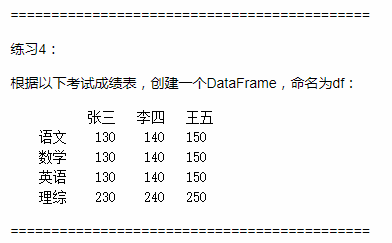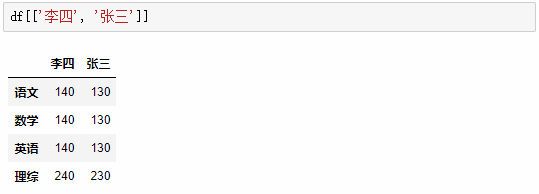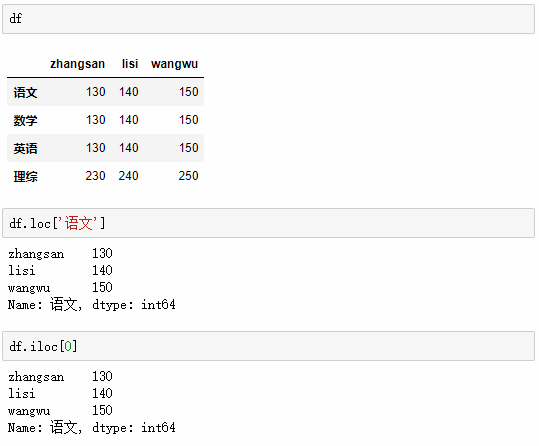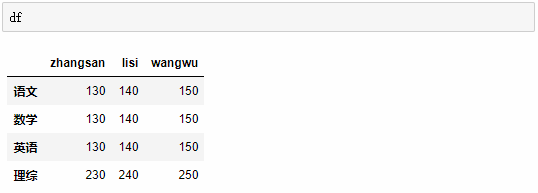一.Numpy
1.使用np.array()创建数组
import numpy as np
np.array([1, 2, 3, 4, 5]) # 创建一个一维数组
np.array([[1,2,3,4], [5,6,7,8]]) # 创建一个二维数组
# 注意:
(1)numpy默认ndarray的所有元素的类型是相同的
(2)如果传进来的列表中包含不同的类型, 则统一为同一类型, 优先级: str > float > int2.使用np的函数创建数组
import numpy as np
# np.ones(shape, dtype=None, order='C')
np.ones(shape=(5, 6), dtype=int) # 创建一个元素数值为1, 形状为5行5列的二维数组
# np.zeros(shape, dtype=None, order='C')
np.zeros((5, 5)) # 创建一个元素数值为0, 形状为5行5列的二维数组
# np.full(shape, fill_value, dtype=None, order='C')
np.full((5,5),fill_value=999) # 创建一个元素数值为999, 形状为五行五列的二维数组
# np.linspace(start, stop, num=50, endpoint=True, retstep=False, dtype=None)
np.linspace(1,100,num=50) # 创建一个元素数值范围在1到100, 元素个数为50的一维数组
# np.arange([start, ]stop, [step, ]dtype=None)
np.arange(0, 100, 2) #创建一个 元素数值范围为0到100,元素数值步长为2 的一维数组
# np.random.randint(low, high=None, size=None, dtype='l')
np.random.seed(1) # 使用random.seed()方法固定随机性
np.random.randint(0, 100, size=(5, 6)) # 生成一个5行6列的二维数组, 每一个元素的值是0到100的随机数
# np.random.randn(d0, d1, ..., dn)
np.random.seed(1) # 固定随机性
np.random.randn(4, 5, 6) # 标准正太分布
# np.random.random(size=None)
np.random.seed(1) # 固定随机性
np.random.random(size=(3, 3)) # 生成0到1的随机数, 左闭右开3.ndarray的属性
- 4个必须记住的参数:
ndim: 维度shape: 形状(各维度的长度)size: 总长度dtype: 元素类型
# 使用matplotlib.pyplot获取一个numpy数组,数据来源于一张图片
import matplotlib.pyplot as plt
img_arr = plt.imread('./wnh.jpg') # 读取图片数据,返回一个三维数组
plt.imshow(img_arr) # 显示该图片
img_arr.shape # 数组的形状
img_arr.size # 数组的总长度
img_arr.dtype # 数组元素的类型
img_arr.ndim # 数组的维度(几维数组)4.ndarray的基本操作
首先创建一个数组, 如下所示:
import numpy as np
np.random.seed(1)
arr = np.random.randint(0, 100, size=(5, 5)) # 创建一个元素范围是0到100,形状是5行5列的随机数组
arr##执行结果如下:
array([[37, 12, 72, 9, 75],
[ 5, 79, 64, 16, 1],
[76, 71, 6, 25, 50],
[20, 18, 84, 11, 28],
[29, 14, 50, 68, 87]])(1)索引
# 根据索引查看元素. 注意:索引从0开始计数.
arr[0][0]
##执行结果如下:
37# 根据索引修改元素数值
arr[0][0] = 666
arr
##执行结果如下:
array([[666, 12, 72, 9, 75],
[ 5, 79, 64, 16, 1],
[ 76, 71, 6, 25, 50],
[ 20, 18, 84, 11, 28],
[ 29, 14, 50, 68, 87]])(2)切片
# 查看当前数组
arr
##执行结果如下:
array([[666, 12, 72, 9, 75],
[ 5, 79, 64, 16, 1],
[ 76, 71, 6, 25, 50],
[ 20, 18, 84, 11, 28],
[ 29, 14, 50, 68, 87]])# 获取二维数组前两行
arr[0:2]
##执行结果如下:
array([[666, 12, 72, 9, 75],
[ 5, 79, 64, 16, 1]])# 获取二位数组前两列
arr[:,0:2]
##执行结果如下:
array([[666, 12],
[ 5, 79],
[ 76, 71],
[ 20, 18],
[ 29, 14]])注意: 逗号左边是行切片, 右边是列切片
# 获取二维数组前两行和前两列的数据
arr[0:2, 0:2]
##执行结果如下:
array([[666, 12],
[ 5, 79]])# 将数组的行 倒序排列
arr[::-1,::]
##执行结果如下:
array([[ 29, 14, 50, 68, 87],
[ 20, 18, 84, 11, 28],
[ 76, 71, 6, 25, 50],
[ 5, 79, 64, 16, 1],
[666, 12, 72, 9, 75]])# 将数组的列 倒序排列
arr[::, ::-1]
##执行结果如下:
array([[ 75, 9, 72, 12, 666],
[ 1, 16, 64, 79, 5],
[ 50, 25, 6, 71, 76],
[ 28, 11, 84, 18, 20],
[ 87, 68, 50, 14, 29]])# 将数组的行和列 都进行倒序排列
arr[::-1, ::-1]
##执行结果如下:
array([[87, 68, 50, 14, 29],
[28, 11, 84, 18, 20],
[50, 25, 6, 71, 76],
[ 1, 16, 64, 79, 5],
[75, 9, 72, 12, 37]])(3)变形
- 将一维数组变形成多维数组
import numpy as np
arr_1 = np.arange(0, 100, 4) # 创建一个元素范围为0到100,元素步长为4的一维数组
arr_1.reshape((-1, 5)) # 将一维数组变形成多维数组##执行结果如下:
array([[ 0, 4, 8, 12, 16],
[20, 24, 28, 32, 36],
[40, 44, 48, 52, 56],
[60, 64, 68, 72, 76],
[80, 84, 88, 92, 96]])- 将多维数组变形成一维数组
import numpy as np
np.random.seed(1) # 固定随机性
arr_2 = np.random.randint(0, 100, size=(5, 5)) # 创建一个5行5列的随机数组
arr_2 = arr_2.reshape((25,)) # 将多维数组变形成一维数组
arr_2##执行结果如下:
array([37, 12, 72, 9, 75, 5, 79, 64, 16, 1, 76, 71, 6, 25, 50, 20, 18, 84, 11, 28, 29, 14, 50, 68, 87])(4)级联
语法: np.concatenate((arr1, arr2), axis=1)
参数:
- arr1, arr2表示要级联的数组
- axis=1表示横向级联, axis=0表示纵向级联
横向级联
import numpy as np
np.random.seed(1) # 固定随机性
arr = np.random.randint(0, 100, size=(5, 5)) # 创建一个5行5列的随机数组
arr
##执行结果如下:
array([[37, 12, 72, 9, 75],
[ 5, 79, 64, 16, 1],
[76, 71, 6, 25, 50],
[20, 18, 84, 11, 28],
[29, 14, 50, 68, 87]])np.concatenate((arr, arr), axis=1) # 将数组arr进行横向级联
##执行结果如下:
array([[37, 12, 72, 9, 75, 37, 12, 72, 9, 75],
[ 5, 79, 64, 16, 1, 5, 79, 64, 16, 1],
[76, 71, 6, 25, 50, 76, 71, 6, 25, 50],
[20, 18, 84, 11, 28, 20, 18, 84, 11, 28],
[29, 14, 50, 68, 87, 29, 14, 50, 68, 87]])纵向级联
np.random.seed(6) # 固定随机性
arr1 = np.random.randint(0, 100, size=(4, 5)) # 创建一个4行5列的随机数组
arr1
##执行结果如下:
array([[10, 73, 99, 84, 79],
[80, 62, 25, 1, 75],
[77, 57, 26, 33, 68],
[33, 8, 2, 76, 84]])np.concatenate((arr, arr1), axis=0) # 将数组arr和arr1进行纵向级联
##执行结果如下:
array([[37, 12, 72, 9, 75],
[ 5, 79, 64, 16, 1],
[76, 71, 6, 25, 50],
[20, 18, 84, 11, 28],
[29, 14, 50, 68, 87],
[10, 73, 99, 84, 79],
[80, 62, 25, 1, 75],
[77, 57, 26, 33, 68],
[33, 8, 2, 76, 84]])- 级联需要注意的点:
- 级联的参数是列表: 一定要加中括号或小括号
- 维度必须相同
- 形状相符: 在维度保持一致的前提下, 如果进行横向(axis=1)级联, 必须保证进行级联的数组的行数保持一致. 如果进行纵向(axis=0)级联, 必须保证进行级联的数组的列数保持一致
- 可以通过axis参数改变级联的方向
(5)切分
- 与级联类似, 三个函数完成切分工作:
- np.split(arr, 行/列号, 轴)
- 注意: 参数2是一个列表类型
- np.vsplit()
- np.hsplit()
- np.split(arr, 行/列号, 轴)


(6)副本
import numpy as np
np.random.seed(1) # 固定随机性
arr = np.random.randint(0, 100, size=(5, 5)) # 创建一个5行5列的随机数组
arr
##执行结果如下:
array([[37, 12, 72, 9, 75],
[ 5, 79, 64, 16, 1],
[76, 71, 6, 25, 50],
[20, 18, 84, 11, 28],
[29, 14, 50, 68, 87]])a = arr.copy() # 可以使用copy()函数创建副本,这样做不会对原数据造成影响
a[2][2] = 666 # 修改副本的数据不会对原数据造成影响
arr
##执行结果如下:
array([[37, 12, 72, 9, 75],
[ 5, 79, 64, 16, 1],
[76, 71, 6, 25, 50],
[20, 18, 84, 11, 28],
[29, 14, 50, 68, 87]])a
##执行结果如下:
array([[ 37, 12, 72, 9, 75],
[ 5, 79, 64, 16, 1],
[ 76, 71, 666, 25, 50],
[ 20, 18, 84, 11, 28],
[ 29, 14, 50, 68, 87]])5.ndarray的聚合操作
(1)求和np.sum()
import numpy as np
np.random.seed(1) # 固定随机性
arr = np.random.randint(0, 100, size=(5, 5)) # 创建一个5行5列的随机数组
arr
##执行结果如下:
array([[37, 12, 72, 9, 75],
[ 5, 79, 64, 16, 1],
[76, 71, 6, 25, 50],
[20, 18, 84, 11, 28],
[29, 14, 50, 68, 87]])- axis=1 对所有行求和
arr.sum(axis=1) # axis=1 对所有行求和
##执行结果如下:
array([205, 186, 228, 161, 248])- axis=0 对所有列求和
arr.sum(axis=0) # axis=0 对所有列求和
##执行结果如下:
array([167, 215, 276, 129, 241])(2)最大最小值: np.max()和np.min()
arr.max(axis=1) # 求每一行的最大值
arr.max(axis=0) # 求每一列的最大值
arr.min(axis=1) # 求每一行的最小值
arr.min(axis=0) # 求每一列的最小值(3)平均值: np.mean()
arr.mean(axis=1) # 求每一行的平均值
arr.mean(axis=0) # 求每一列的平均值(4)其他聚合操作
| Function Name | NaN-safe Version | Description |
|---|---|---|
| np.sum | np.nansum | Compute sum of elements |
| np.prod | np.nanprod | Compute product of elements |
| np.mean | np.nanmean | Compute mean of elements |
| np.std | np.nanstd | Compute standard deviation |
| np.var | np.nanvar | Compute variance |
| np.min | np.nanmin | Find minimum value |
| np.max | np.nanmax | Find maximum value |
| np.argmin | np.nanargmin | Find index of minimum value |
| np.argmax | np.nanargmax | Find index of maximum value |
| np.median | np.nanmedian | Compute median of elements |
| np.percentile | np.nanpercentile | Compute rank-based statistics of elements |
| np.any | N/A | Evaluate whether any elements are true |
| np.all | N/A | Evaluate whether all elements are true |
| np.power | 幂运算 |
6.ndarray的排序
快速排序
np.sort()与ndarray.sort()都可以, 但有区别:
np.sort()不改变输入ndarray.sort()本地处理, 不占用空间, 但改变输入
np.sort(arr, axis=1) # 对每一行进行升序排序
np.sort(arr, axis=0) # 对每一列进行升序排序二.Pandas
1.Series
Series是一种类似于一维数组的对象, 由下面两个部分组成:
- values: 一组数据(ndarray类型)
- index: 相关的数据索引标签
(1)Series的创建
a.由列表或numpy数组创建
# 导入pandas三剑客:
from pandas import Series, DataFrame
import pandas as pd
import numpy as np# 使用列表创建Series
s = Series(data=[1, 2, 3], index=['a', 'b', 'c'])
s
##执行结果:
a 1
b 2
c 3
dtype: int64# 使用numpy创建Series
s1 = Series(data=np.random.randint(0, 100, size=(3,)))
s1
##执行结果:
0 32
1 25
2 30
dtype: int32s.index # 查看索引
s.values # 查看值b. 由字典创建: 不能使用index, 但是依然存在默认索引
# 使用字典创建Series
dic = {
'name': '王力宏',
'gender': '男',
}
s2 = Series(dic)
s2
##执行结果:
gender 男
name 王力宏
dtype: object小练习: 使用多种方法创建以下Series,命名为s1
语文 150
数学 150
英语 150
理综 300
dic = {
'语文': 150,
'数学': 150,
'英语': 150,
'理综': 300,
}
s1 = Series(dic)
s1
##执行结果:
数学 150
理综 300
英语 150
语文 150
dtype: int64s2 = Series(data=[150, 150, 150, 300], index=['语文', '数学', '英语', '理综'])
s2
##执行结果:
语文 150
数学 150
英语 150
理综 300
dtype: int64(2)Series的索引和切片
显示索引:
- 使用index中的元素作为索引值
- 使用
s.loc[](推荐)- 注意: loc中括号里面放置的一定是显示索引
- 注意: 此时是闭区间
s2['语文']
##执行结果:
150s2.loc['理综']
##执行结果:
300隐式索引:
- 使用整数作为索引值
- 使用
.iloc(推荐)- 注意:
iloc的中括号里面必须放置隐式索引 - 注意: 此时是半开区间
- 注意:
s2[1]
##执行结果:
150s2.iloc[1]
##执行结果:
150索引切片:
dic = {
'math':100,
'English':88
}
s3 = Series(data=dic)
s3
##执行结果:
English 88
math 100
dtype: int64s3.iloc[0:1]
##执行结果:
English 88
dtype: int64(3)Series的基本概念
- 可以把Series看成是一个定长的有序字典
- 向Series增加一行: 相当于给字典增加一组键值对
dic = {
'math':100,
'English':88
}
s3 = Series(data=dic)s3['Chinese'] = 100
s3
##执行结果:
English 88
math 100
Chinese 100
dtype: int64- 可以通过shape, size, index, values等得到series的属性
s3.shape
##执行结果:
(3,)s3.size
##执行结果:
3s3.index
##执行结果:
Index(['English', 'math', 'Chinese'], dtype='object')s3.values
##执行结果:
array([ 88, 100, 100], dtype=int64)- 可以使用
s.head(),s.tail()分别查看前n个和后n个值
s3.head(2) # 查看前2个值
##执行结果:
English 88
math 100
dtype: int64s3.tail(2) # 查看后2个值
##执行结果:
math 100
Chinese 100
dtype: int64- 对Series元素进行去重:
unique()
s = Series([1,1,2,2,3,3,3,3,3,4,5,6,5,5,3,5,1])
s.unique()
##执行结果:
array([1, 2, 3, 4, 5, 6], dtype=int64)- 使得两个Series进行相加
s1 = Series(data=[1, 2, 3, 4, 5], index=['A', 'B', 'C', 'D', 'E'])
s2 = Series(data=[1, 2, 3, 4, 5], index=['A', 'B', 'C', 'D', 'E'])
s = s1 + s2
s
##执行结果:
A 2
B 4
C 6
D 8
E 10
dtype: int64- 当索引没有对应的值时, 可能出现缺失数据显示
NaN(not a number)的情况
s1 = Series(data=[1, 2, 3, 4, 5], index=['A', 'B', 'C', 'D', 'E'])
s2 = Series(data=[1, 2, 3, 4, 5], index=['A', 'B', 'C', 'F', 'E'])
s = s1 + s2
s
##执行结果:
A 2.0
B 4.0
C 6.0
D NaN
E 10.0
F NaN
dtype: float64- 可以使用
pd.isnull(),pd.notnull(), 或s.isnull(),s.notnull()函数检测缺失的数据
s.notnull()
##执行结果:
A True
B True
C True
D False
E True
F False
dtype: bools[['A', 'B', 'C']] # 显示索引查看值
##执行结果:
A 2.0
B 4.0
C 6.0
dtype: float64s[[0, 1]] # 隐式索引查看值
##执行结果:
A 2.0
B 4.0
dtype: float64s[[True, False, True, True, True, False]] # True表示显示该值,False表示不显示
##执行结果:
A 2.0
C 6.0
D NaN
E 10.0
dtype: float64s[s.notnull()] # 这个语法表示: 显示s中所有非空的值
##执行结果:
s[s.notnull()] # 这个语法表示: 显示s中所有非空的值
s[s.notnull()] # 这个语法表示: 显示s中所有非空的值
A 2.0
B 4.0
C 6.0
E 10.0
dtype: float64(4)Series的运算
+,-,*,/
略
add(),sub(),mul(),div()
add()的语法是这样的:s1.add(s2, fill_value=0)
s1 = Series(data=[1, 2, 3, 4, 5], index=['A', 'B', 'C', 'D', 'E'])
s2 = Series(data=[1, 2, 3, 4, 5], index=['A', 'B', 'C', 'F', 'E'])
s1.add(s2)
##执行结果:
A 2.0
B 4.0
C 6.0
D NaN
E 10.0
F NaN
dtype: float64- Series之间的运算
- 在运算中自动对齐不同索引的数据
- 如果索引不对应, 则自动补NaN
2.DataFrame
DataFrame是一个表格型的数据结构. DataFrame由按照一定顺序排列的多列数据组成. 设计初衷是将Series的使用场景从一维拓展到多维. DataFrame既有行索引, 也有列索引.
- 行索引: index
- 列索引: columns
- 值: values
(1)DataFrame的创建
最常用的方法是传递一个字典来创建. DataFrame以字典的键作为每一列的名称, 以字典的值(一个数组)作为每一列.
此外, DataFrame会自动加上每一行的索引.
使用字典创建DataFrame后, 则columns参数将不可被使用.
同Series一样, 若传入的列与字典的键不匹配, 则相应的值为NaN.
- 使用ndarray创建DataFrame
df = DataFrame(data=np.random.randint(60, 120, size=(5, 5)), index=['a', 'b', 'c', 'd', 'e'])
df
- DataFrame属性: values, columns, index, shape
df.values
df.columns
df.index
df.shape
- 小练习:

dic = {
'张三': [130, 130, 130, 230],
'李四': [140, 140, 140, 240],
'王五': [150, 150, 150, 250],
}
df = DataFrame(data=dic, index=['语文', '数学', '英语', '理综'])
df
(2)DataFrame的索引
- 对列进行索引
- 通过类似字典的方式: df['q']
- 通过属性的方式: df.q
可以将DataFrame的列获取为一个Series. 返回的Series拥有原DataFrame相同的索引, 且name属性也已经设置好了, 就是相应的列名.



- 对行进行索引
- 使用
.loc[]加index来进行 行索引 - 使用
.iloc[]加整数来进行 行索引
- 使用

- 对元素索引的方法
- 使用列索引
- 使用行索引
(iloc[3, 1] or loc['C', 'q'])- 注意: 行索引在前, 列索引在后

- 切片
- 注意: 使用中括号时
- 索引表示的是列索引
- 切片表示的是行切片


(3)DataFrame的运算
(1)DataFrame之间的运算
同Series一样:
- 在运算中自动对齐不同索引的数据
- 如果索引不对应, 则不NaN

略